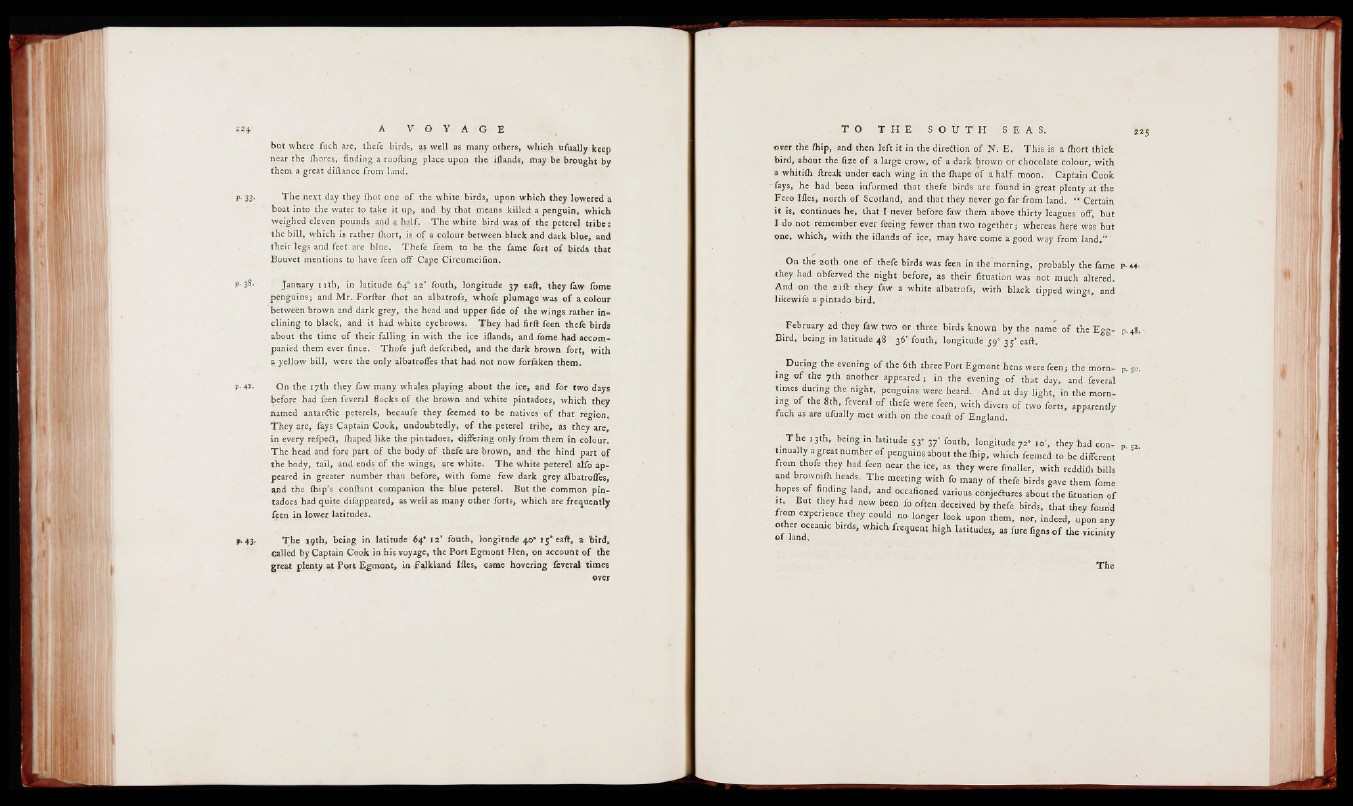
but where fuch are, thefe birds, as well as many others, which ufoally keep
near the ihores, finding a ropfting place upon the ¡{lands, may be brought by
them a great diftance from land.
p. 33. The next day they ihot one of the white birds, upon which they lowered a
boat into the water to take it up, and by that means killed a penguin, which
weighed eleven pounds and a half. The white bird was of the peterel tribe:
the bill, which is rather iliort, is o f a colour between black and dark blue, and
their legs and feet are blue. Thefe feem to be the fame fort of birds that
Bouvet mentions to have feen off Cape Circumcifion.
P-38* January n th , in latitude 64° 12’ fouth, longitude 37 eaft, they few fome
penguins; and Mr. Forfter ihot an albatrofs, whofe plumage was of a colour
between brown and dark grey, the head and upper fide of the wings rather inclining
to black, and it had white eyebrows. They had firft feen thefe birds
about the time of their falling in with the ice iflands, and fome had accompanied
them ever fince. Thofe juft defcribed, and the dark brown fort, with
a yellow bill, were the only albatroffes that had not now forfaken them.
p- 42- On the 17th they faw many whales playing about the ice, and for two days
before had feen feveral flocks of the brown and white pintadoes, which they
named antar&rc peterels, becaufe they feemed to be natives of that region.
They are, fays Captain Cook, undoubtedly, of the peterel tribe, as they are,
in every refpeft, ihaped like the pintadoes, differing only from them in colour.
The head and fore part of the body of thefe are brown, and the hind part o f
the body, tail, and ends of the wings, are white. The white peterel alfo appeared
in greater number than before, with fome few dark grey albatrofles,
and the ihip’s conftant companion the blue peterel. But the common pintadoes
had quite difappeared, as well as many other forts, which are frequently
feen in lower latitudes.
f.43. The 19th, being in latitude 64* 12’ fouth, longitude 40* i5*eaft, a bird,
called by Captain Cook in his voyage, the Port Egmont Hen, on account o f the
great plenty at Port Egmont, in Falkland liles, came hovering feveral times
over
over the /hip, and then left it in the diredtion of N. E. This is a /hort thick
bird, about the fize of a large crow, of a dark brown or chocolate colour, with
a whitiih ftreak under each wing in the fhape of a half moon. Captain Cook
'fays, he had been informed that thefe birds are found in great plenty at the
Fero Ifles, north of Scotland, and that they never go far from land. “ Certain
it is, continues he, that I never before faw them above thirty leagues off, but
I do not remember ever feeing fewer than two together; whereas here was but
one, which, with the iflands of ice, may have come a good way from land.”
On the 20th one of thefe birds was feen in the morning, probably the feme p*44*
they had obferved the night before, as their fituation was -not much altered.
And on the 21ft they few a white albatrofs, with black tipped wings, and
likewife a pintado bird.
February 2d they few two or three birds known by the name of the Egg- p. 48.
Bird, being in latitude 48 36’ fouth, longitude 590 3^’ eaft.
During the evening of the 6th three Port Egmont hens were feen; the morn- p. 50.
ing o f the 7th another appeared ; in the evening of that day, and feveral
times during the night, penguins were heard. And at day light, in the morning
of the 8th, feveral of thefe were feen, with divers of two forts, apparently
fuch as are ufoally met with on the coaft of England.
T he 13th, being in latitude 53» 37’ fouth, longitude 72° 10’, they 1iad con- p. « .
tinualiy a great number of penguins about the ihip, which feemed to be different
from thofe they had feen near the ice, as they were fmaller, with reddifli bills
and browm/h heads. The meeting with fo many of thefe birds gave them fome
hopes of finding land, and occafioned various conje&ures about the fituation of
m But they had now been fo often deceived by thefe birds, that they found
from experience they could no> longer look upon them, nor, indeed, upon any
other oceanic birds, which frequent high latitudes, as fore figns o f the vicinity
The